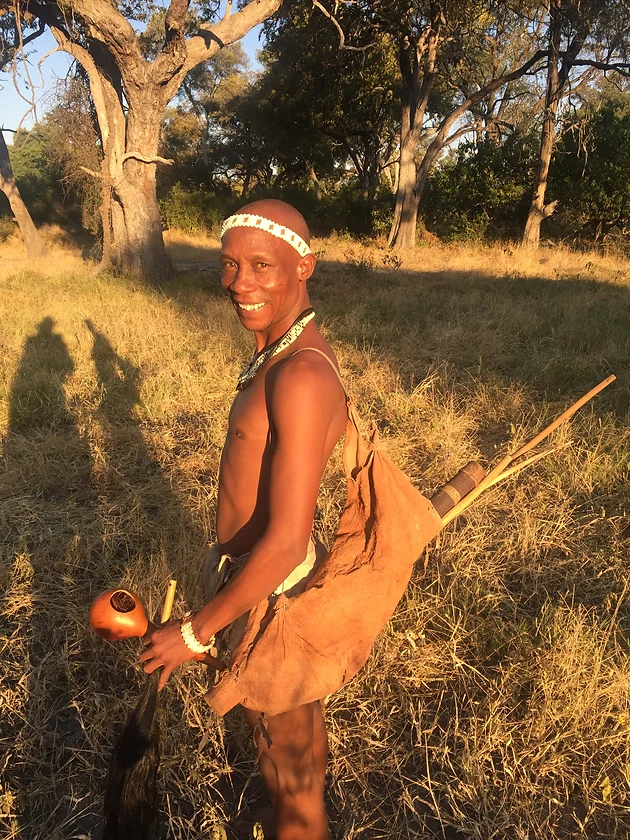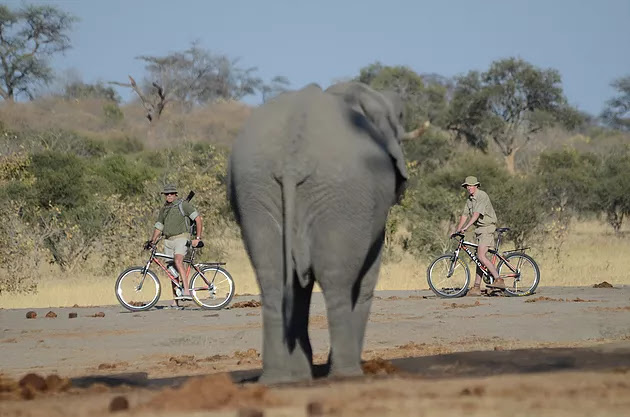Leopard in camp

We awoke at 5:30AM this morning as per usual safari schedule and had a quick coffee with a light breakfast before setting out to the northern edge of the concession. We found a male lion’s track shorty after driving out of camp but he evaded our search so we continued on the meet our mokoro canoe guide at the edge of the river. Traveling by mokoro is one of the highlights of lodging at any water camp in the Okavango Delta. These traditional long canoes were originally hand carved of hard wood from the sausage tree and provided the only means of transport for the indigenous bushman to travel between tribal communities. Today I am guided a weathered bushman named Simon who has spent his life plying these waters among the hippos and crocs. It is a privilege to be in the presence of a guide like Simon whose knowledge of the delta is unparalleled. He immediately points out hidden creatures as he polls our boat expertly through the waist deep channels. Here a spider, there a fish, perched above a fish eagle and swimming below are bream. Soon we come to an open channel and Simon cautiously slows our boat as he searches for danger. Sure enough, a hippo has just passed as evidenced by the munched grasses. A croc lies on the far shore watching carefully then swiftly submerges. Simon taps the boat several times to warn him off. As we travel further into the reeds we enter a world of green where water lilies stretch to the horizon and the piercing blue sky reflects on the still waters surface. Simon tells me of his childhood growing up in this remote corner of the world. He tells of multi day journeys to the edge of the delta to meet distant relatives. He says he has been paddling since he was 5 and that he was born in 1950. His english is broken but his spirit and enthusiasm carry the day. It is such a pleasure to travel silently by boat, smoothly gliding through the network of channels that criss cross over fifty thousand square miles. Simon shows me an elephant crossing and tells me if we come back at sunset there will be a breeding herd crossing this channel. He shows me other channels that are much narrower where hippos have carved paths to their ancestral homes. I marvel at his sense of direction. How he knows each channel, every bend and curve, and after two hours he has effortlessly guided us back to the exact spot where we began. Amazing.
We tracked some lion on the way back to camp but had no luck. Sometimes safaris can be hit or miss and it is important to avoid getting fixated on seeing one specific animal. The scenery was superb - vast gassy plains dotted with large old growth trees that stood out like islands in the plains. As we approached camp for a late brunch a huge male leopard darted across our path not 10 feet away and then crouched down on the side of the road affording us an excellent view of his gorgeous body. This male has been hanging around camp killing baboons at night according to the camp manager, Dix. Another leopard sighting and this one was in broad daylight - what luck!
Equally amazing is the bush walk that we undertook this evening. My guide, Diesel, and a fellow camp staff Max took me on their signature bushman cultural walk. They dressed in traditional garb and walked barefoot carrying traditional bush tools like an axe and tools to make fire. This was one of the most authentic experiences I have had in Africa. We set out on foot from camp armed with only bows, arrows and spears. As we walked my guide explained the bushman’s adaptation to his environment. Soon we were looking at medicinal plants that could cure bad stomach, induce abortion, provide insect repellent and much more. It was fascinating to explore bushman survival techniques. How they would hide in waiting near an impala midden (mound of feces) where a male challenger would come to drop his scent announcing his candidacy to take over the herd. The bushman would then shoot the impala with his bow and arrow. He talked about how the various parts of the animal were shared among the tribe. The head went to the wise uncle as a sign of respect, the back went to the hunting companion that watched his rear, the heart went to his wife, the legs to the children, and so on. As we walked a family of warthogs came trotting along out of the bushes and stumbled right into us before realizing the danger and scouting off huffing into the distance. Their eyesight is so poor they make an easy meal for many predators cats. Soon we came upon a herd of zebras. As we were downwind we were able to stealthily approach to within 30 feet before the guard gave the alarm and the herd bounded off into the thickets. Next we came onto some impala. their reddish brown coats shone majestically in the setting sunlight. We stopped by a tree and the guides showed me how they make fire from friction. They gathered a large piece of elephant dung and demonstrated how they can carry the fire with them all day to their next camp as a smoldering coal within the dung. We talked about how they smoke the bees out to gather honey and how the smoke from the elephant dung was used to keep mosquitos away. The depth pf knowledge was mind boggling and gave me a real appreciation of how these people have lived in harmony with their environment for thousands of years. In fact, these are the descendants of the earliest humans - the Khoisan people. We know them as the San Bushman of the Kalahari. Their tribe followed the migrating animals out of Namibia and into the delta where the adapted to the aquatic world by learning to fish and canoe. They are now called the Bukakwa people. It feels great to support these bushman as they are creating a very unique safari experience while giving back tho their communities in the form of jobs and funding for schools and food.

Comments
Post a Comment